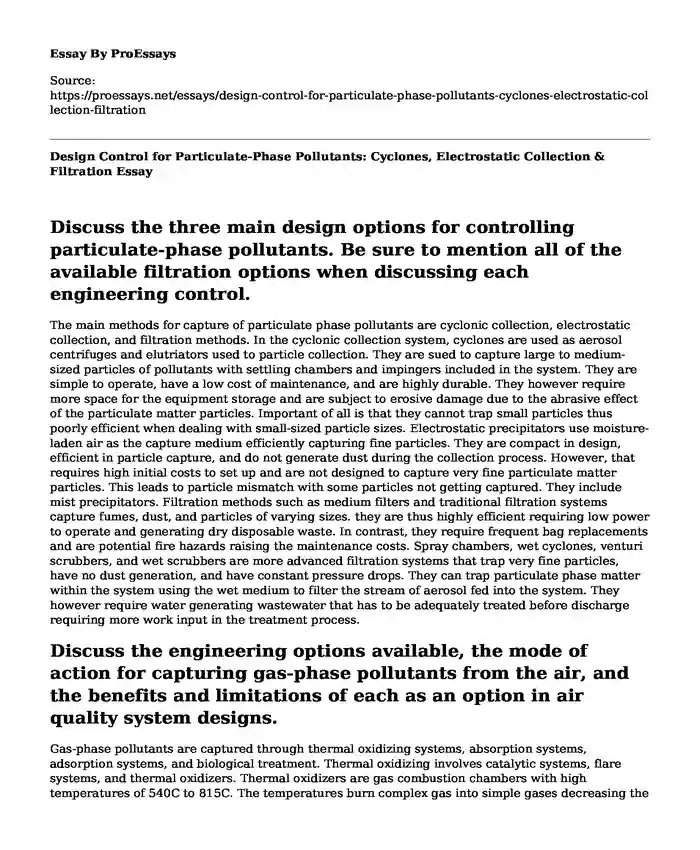Discuss the three main design options for controlling particulate-phase pollutants. Be sure to mention all of the available filtration options when discussing each engineering control.
The main methods for capture of particulate phase pollutants are cyclonic collection, electrostatic collection, and filtration methods. In the cyclonic collection system, cyclones are used as aerosol centrifuges and elutriators used to particle collection. They are sued to capture large to medium-sized particles of pollutants with settling chambers and impingers included in the system. They are simple to operate, have a low cost of maintenance, and are highly durable. They however require more space for the equipment storage and are subject to erosive damage due to the abrasive effect of the particulate matter particles. Important of all is that they cannot trap small particles thus poorly efficient when dealing with small-sized particle sizes. Electrostatic precipitators use moisture-laden air as the capture medium efficiently capturing fine particles. They are compact in design, efficient in particle capture, and do not generate dust during the collection process. However, that requires high initial costs to set up and are not designed to capture very fine particulate matter particles. This leads to particle mismatch with some particles not getting captured. They include mist precipitators. Filtration methods such as medium filters and traditional filtration systems capture fumes, dust, and particles of varying sizes. they are thus highly efficient requiring low power to operate and generating dry disposable waste. In contrast, they require frequent bag replacements and are potential fire hazards raising the maintenance costs. Spray chambers, wet cyclones, venturi scrubbers, and wet scrubbers are more advanced filtration systems that trap very fine particles, have no dust generation, and have constant pressure drops. They can trap particulate phase matter within the system using the wet medium to filter the stream of aerosol fed into the system. They however require water generating wastewater that has to be adequately treated before discharge requiring more work input in the treatment process.
Discuss the engineering options available, the mode of action for capturing gas-phase pollutants from the air, and the benefits and limitations of each as an option in air quality system designs.
Gas-phase pollutants are captured through thermal oxidizing systems, absorption systems, adsorption systems, and biological treatment. Thermal oxidizing involves catalytic systems, flare systems, and thermal oxidizers. Thermal oxidizers are gas combustion chambers with high temperatures of 540C to 815C. The temperatures burn complex gas into simple gases decreasing the toxicity potential. They also release carbon monoxide and carbon dioxide gases as products of the combustion process that contribute to air quality pollution. They are however advantageous being very efficient and require low maintenance. Flare systems are used to combust hydrocarbon-rich gases within the explosive limit (slightly below the upper explosive limit and slightly above the lower explosive limit.) They work at 99% efficiency guaranteeing high-quality control. They are also subject to the major flaw of producing by-product combustion gases (carbon dioxide and carbon monoxide) that increase the air quality pollution level. Additionally, natural gases are used to keep the pilot lit and as a prime for the combustion increasing the combustion by-products. Catalytic systems include catalytic converters and catalytic oxidizers which are catalytic filled filters that combust gases near the lower explosive limit to treat the gases at 370c to 480C. This system has a small carbon footprint with low fuel consumption in comparison to other systems. They also have low maintenance costs and are associated with an advantageous low system pressure drop. They are limited by clogging of the catalytic converter, high costs of replacement of the catalyst, and heavy impact by cold temperatures. Adsorption systems work through the principle of adherence of gas molecules through Van der Waal attractional forces on both solid and liquid media. Solid media systems containing activated charcoal, plastic beads, metal, and glass are used to create a sorbent environment. The used materials are dictated by the polarity of the as molecules in target proving high-efficiency trapping of the desired gas particles. Specific gases can be targeted for destruction by incorporating high-temperature gases. The disadvantages of the system include system clogging due to the high-pressure gas system. Additionally, fire risk is elevated depending on the material used and gases targeted. Activated charcoal becomes a fire hazard when flammable gases are adsorbed to it. Liquid media systems used fluid that targets adsorption of particular gas molecules. They are allowed fluid reuse and recycle making them highly efficient. However, they require high costs for the right fluids for gas adsorption and fixing of corrosion problems. There is also a strong risk of contamination of the system. Absorption systems which can be solid or liquid allow gas adsorption through scrubbers. Solid-phase media scrubbers consist of packed media such as lime and calcium carbonate and other pack media that capture gas molecules. Liquid phase media scrubbers used water mixed with selected mineral slurries or acids cleaning gas streams passed through the system. Absorption systems have similar limitations and advantageous as adsorption systems. Biologic treatment systems digest breaking down the gases. They have high efficiency but require high maintenance to keep microbes in the packing beds and biofilters alive with the correct temperature and pressure conditions for each microbe required.
Cite this page
Design Control for Particulate-Phase Pollutants: Cyclones, Electrostatic Collection & Filtration. (2023, Oct 29). Retrieved from https://proessays.net/essays/design-control-for-particulate-phase-pollutants-cyclones-electrostatic-collection-filtration
If you are the original author of this essay and no longer wish to have it published on the ProEssays website, please click below to request its removal:
- The Effect of Economic Growth to Climate Change - Essay Sample
- The Future of Design Teams and BIM Essay
- Renewable and Nonrenewable Sources Essay
- Engineer's Professional and Technical Competencies Paper Example
- Essay Sample on Canada's Floods: A Growing Risk and Government Responsibility
- Essay Example on Rising Sea Levels due to Climate Change
- Essay Sample on Plastic Straws to Be Banned







